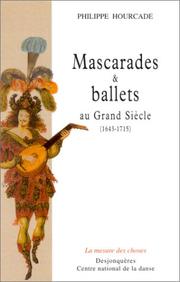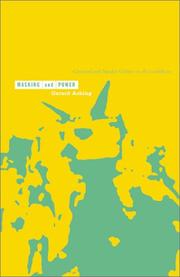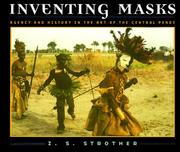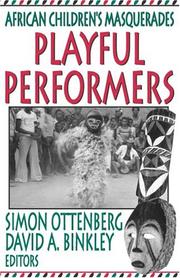| Listing 1 - 10 of 10 |
Sort by
|
Book
ISBN: 2040153659 9782040153656 Year: 1988 Publisher: Paris : Bordas,
Abstract | Keywords | Export | Availability | Bookmark
 Loading...
Loading...Choose an application
- Reference Manager
- EndNote
- RefWorks (Direct export to RefWorks)
Carnival. --- Masquerades. --- Carnavals --- Mascarades
Book
ISBN: 9782355391767 2355391769 Year: 2014 Publisher: Lavérune : L'Entretemps éditions,
Abstract | Keywords | Export | Availability | Bookmark
 Loading...
Loading...Choose an application
- Reference Manager
- EndNote
- RefWorks (Direct export to RefWorks)
La fête, la mascarade, le carnaval cristallisent la rupture avec le quotidien, elles incarnent le débordement, le désordre et l'excès. Ses pratiques ne se réduisent pas à une seule caractéristique, restreinte aux célébrations ou aux commémorations collectives, sacrées ou profanes. Elles sont composées de multiples facettes : l'ensauvagement, le renversement, le désordre, le comique, le grotesque, la bouffonnerie, le rire, etc. Elles ont traversé les époques et les espaces. Ces formes spectaculaires et collectives, ces pratiques esthétiques oscillent entre le licite et l'illicite, le discrédit et la reconnaissance, l'homogène et l'hétérogène. La fête, la mascarade et le carnaval tels qu'ils sont présentés dans cet ouvrage, sont abordés comme des « faits sociaux totaux ». Ils sont examinés, pensés et observés dans leur dimension esthétique et artistique, économique, politique et sociale. Ce livre ne propose pas une liste exhaustive des fêtes dans le monde, ni un inventaire des pratiques, même si son spectre géographique est assez large. Il prétend néanmoins renouveler la pensée sur des questions d'esthétique et de savoir-faire, sur la circulation des formes artistiques - tant géographiques que symboliques - et sur les processus de revendications identitaires contemporains.
Fêtes --- Mascarades --- Carnavals --- Fêtes. --- Mascarades. --- Carnavals. --- Fêtes.

ISBN: 2843210518 9782843210518 Year: 2002 Publisher: Paris : Paris : Desjonquères ; Centre national de la danse,
Abstract | Keywords | Export | Availability | Bookmark
 Loading...
Loading...Choose an application
- Reference Manager
- EndNote
- RefWorks (Direct export to RefWorks)
Issue d'une vieille tradition nationale fécondée à la Renaissance par des influences italiennes, la danse de fête dans la France du XVIIe siècle se déploie sous le règne du Roi Soleil. Elle prend alors les dimensions d'un prodigieux phénomène de société : c'est tout un pays, du peuple jusqu'aux palais, qui, pour oublier les rigueurs des temps ou pour célébrer la gloire des grands, est emporté par la danse. Apparenté au bal et à la mascarade de carnaval, le ballet envahit les fêtes des collèges, s'introduit dans les formes dramatiques, les métamorphose en comédies-ballets, en tragédies-ballets et même en opéras-ballets. De cet immense foisonnement, le ballet représenté à la cour n'est que la forme suprême. C'est ce phénomène que, pour la première fois, Philippe Hourcade tente ici de retracer dans toute son ampleur. Ce livre est complété de l'édition de témoignages essentiels de l'époque et enrichi des répertoires des danseurs de la cour ainsi que de tous les ballets exécutés sous Louis XIV (1643-1715).
Ballet --- Masquerades --- Mascarades --- History --- Histoire
Book
Abstract | Keywords | Export | Availability | Bookmark
 Loading...
Loading...Choose an application
- Reference Manager
- EndNote
- RefWorks (Direct export to RefWorks)
Folklore --- Sciences sociales --- Sociale wetenschappen --- Mascarades --- Maskerades --- 394.25 (100) (064)

ISBN: 0816640181 0816640173 Year: 2002 Volume: 8 Publisher: Minneapolis, Minn. University of Minnesota Press
Abstract | Keywords | Export | Availability | Bookmark
 Loading...
Loading...Choose an application
- Reference Manager
- EndNote
- RefWorks (Direct export to RefWorks)
An ambitious reassessment of the political uses of masking. Does the mask reveal more than it conceals? What, this book asks, becomes visible and invisible in the masking practiced in Caribbean cultures—not only in the familiar milieu of the carnival but in political language, social conduct, and cultural expressions that mimic, misrepresent, and mislead? Focusing on masking as a socially significant practice in Caribbean cultures, Gerard Aching's analysis articulates masking, mimicry, and misrecognition as a means of describing and interrogating strategies of visibility and invisibility in Cuba, Trinidad and Tobago, Martinique, and beyond. Masking and Power uses ethnographic fieldwork, psychoanalysis, and close literary readings to examine encounters between cultural insiders as these locals mask themselves and one another either to counter the social invisibility imposed on them or to maintain their socioeconomic privileges. Aching exposes the ways in which strategies of masking and mimicry, once employed to negotiate subjectivities within colonial regimes, have been appropriated for state purposes and have become, with the arrival of self-government in the islands, the means by which certain privileged locals make a show of national and cultural unity even as they engage in the privatization of popular culture and its public performances.
Spanish-American literature --- Thematology --- Caribbean Area --- Carnival --- Masquerades --- Popular culture --- Carnavals --- Mascarades --- Culture populaire --- Caraïbes (Région) --- Social conditions. --- Conditions sociales --- Caraïbes (Région) --- Caribbean area --- CARNAVALS --- MASCARADES --- CULTURE POPULAIRE --- REGION CARAÏBE --- CONDITIONS SOCIALES
Book
ISBN: 9781872843605 1872843603 Year: 2007 Publisher: London Saffron books
Abstract | Keywords | Export | Availability | Bookmark
 Loading...
Loading...Choose an application
- Reference Manager
- EndNote
- RefWorks (Direct export to RefWorks)
Masquerades --- Mascarades --- Nigeria --- Cameroon --- Cameroun --- Social life and customs. --- Moeurs et coutumes --- Masks, Chamba. --- Chamba (African people) --- Masks --- Benue State (Nigeria) --- Benue River Region (Cameroon and Nigeria)

ISBN: 0226777324 Year: 1998 Publisher: Chicago and London University of Chicago Press
Abstract | Keywords | Export | Availability | Bookmark
 Loading...
Loading...Choose an application
- Reference Manager
- EndNote
- RefWorks (Direct export to RefWorks)
rituals [events] --- Ethnology. Cultural anthropology --- Pende --- ceremonies --- Folklore --- masks [costume] --- Congo --- Aesthetics, African. --- Masks, Pende. --- Masquerades --- Pende (African people) --- Physiognomy in art --- Sculptors --- Esthétique africaine --- Masques pende --- Mascarades --- Pende (Peuple d'Afrique) --- Physiogonomie dans l'art --- Sculpteurs --- History --- Social life and customs. --- Biography --- Histoire --- Moeurs et coutumes --- Biographie --- History. --- Biography. --- Esthétique africaine --- Aesthetics, African --- Masks, Pende --- Bronze sculptors --- Artists --- Apende (African people) --- Bapende (African people) --- Pende (African tribe) --- Pindi (African people) --- Tupende (African people) --- Bantu-speaking peoples --- Ethnology --- Amusements --- Mumming --- Pende masks --- African aesthetics --- Social life and customs --- Masks

ISBN: 0765802864 Year: 2006 Publisher: New Brunswick Transaction
Abstract | Keywords | Export | Availability | Bookmark
 Loading...
Loading...Choose an application
- Reference Manager
- EndNote
- RefWorks (Direct export to RefWorks)
Masks --- Masquerades --- Children --- Rites and ceremonies --- Folklore --- Folklore and children --- Masques --- Mascarades --- Enfants --- Rites et cérémonies --- Folklore et enfants --- Social aspects --- Social life and customs. --- Performance --- Aspect social --- Moeurs et coutumes --- Interprétation --- Africa --- Afrique --- Ceremonies --- Cult --- Cultus --- Ecclesiastical rites and ceremonies --- Religious ceremonies --- Religious rites --- Rites of passage --- Traditions --- Ritualism --- Manners and customs --- Mysteries, Religious --- Ritual --- Amusements --- Mumming --- Costume --- Carnival --- Folk beliefs --- Folk-lore --- Ethnology --- Material culture --- Mythology --- Oral tradition --- Storytelling --- Children and folklore --- Folk-lore and children --- Folklore and youth --- Youth and folklore --- Youth --- Childhood --- Kids (Children) --- Pedology (Child study) --- Youngsters --- Age groups --- Families --- Life cycle, Human --- Social life and customs
Book
ISBN: 3030394271 3030394263 Year: 2020 Publisher: Cham : Springer International Publishing : Imprint: Palgrave Macmillan,
Abstract | Keywords | Export | Availability | Bookmark
 Loading...
Loading...Choose an application
- Reference Manager
- EndNote
- RefWorks (Direct export to RefWorks)
This book revisits In-Yer-Face theatre, an explosive, energetic theatrical movement from the 1990s that introduced the world to playwrights Sarah Kane, Martin McDonagh, Mark Ravenhill, Jez Butterworth, and many others. Split into three sections the book re-examines the era, considers the movement’s influence on international theatre, and considers its lasting effects on contemporary British theatre. The first section offers new readings on works from that time period (Antony Neilson and Mark Ravenhill) as well as challenges myths created by the Royal Court Theatre about the its involvement with In-Yer-Face theatre. The second section discusses the influence of In-Yer-Face on Portuguese, Russian and Australian theater, while the final section discusses the legacy of In-Yer-Face writers as well as their influences on more recent playwrights, including chapters on Philip Ridley, Sarah Kane, Joe Penhall, Martin Crimp, Dennis Kelly, and Verbatim Drama.
Theater --- Performing arts --- Show business --- Arts --- Performance art --- History. --- Management. --- Theater. --- Theater—History. --- Performing arts. --- Contemporary Theatre. --- Theatre History. --- National/Regional Theatre and Performance. --- Performing Arts. --- Dramatics --- Histrionics --- Professional theater --- Stage --- Theatre --- Acting --- Actors --- Teatre --- Art del teatre --- Art escènic --- Art teatral --- Dramatúrgia --- Escena --- Representació teatral --- Arts de l'espectacle --- Agents teatrals --- Crítica teatral --- Directors teatrals --- Mascarades (Teatre) --- Música d'escena --- Producció i direcció teatral --- Teatre al carrer --- Teatre d'afeccionats --- Teatre de titelles --- Teatre escolar --- Teatre experimental --- Teatre infantil i juvenil --- Teatre musical --- Teatre negre --- Teatre polític --- Vodevil --- Art dramàtic --- Consuetes (Teatre) --- Efectes especials --- Teatre (Gènere literari) --- Teatres
Book
ISBN: 1000545873 1032214147 1032214163 9781032214139 9781032214146 1032214139 Year: 2022 Publisher: Abingdon, Oxon ; New York, New York : Routledge,
Abstract | Keywords | Export | Availability | Bookmark
 Loading...
Loading...Choose an application
- Reference Manager
- EndNote
- RefWorks (Direct export to RefWorks)
"This edited collection explores methods for conducting critical empirical research examining the potential impacts of theatrical events on audience members. Dani Snyder-Young and Matt Omasta present an overview of the burgeoning subfield of audience studies in theatre and performance studies, followed by an introduction to the wide range of ways scholars can study the experiences of spectators. Consisting of chapter length case studies, the book addresses methodologies for examining spectatorship, including qualitative, quantitative, historical/historiographic, arts-based, participatory, and mixed methods approaches. This volume will be of great interest to theatre and performance studies scholars as well as industry professionals working in marketing, audience development and community engagement"--
Theater audiences. --- Theater audiences --- Audiences, Theater --- Theater --- Theatergoers --- Performing arts --- Theater attendance --- Audiences --- Teatre --- Públic --- Art del teatre --- Art escènic --- Art teatral --- Dramatúrgia --- Escena --- Representació teatral --- Arts de l'espectacle --- Agents teatrals --- Crítica teatral --- Directors teatrals --- Mascarades (Teatre) --- Música d'escena --- Producció i direcció teatral --- Teatre al carrer --- Teatre d'afeccionats --- Teatre de titelles --- Teatre escolar --- Teatre experimental --- Teatre infantil i juvenil --- Teatre musical --- Teatre negre --- Teatre polític --- Vodevil --- Actors --- Art dramàtic --- Consuetes (Teatre) --- Efectes especials --- Teatre (Gènere literari) --- Teatres --- Assistència (Públic) --- Audiència --- Espectadors --- Oients --- Visitants --- Audiència (Mitjans de comunicació de massa) --- Teleespectadors --- Consum cultural --- Theater audiences - Case studies
| Listing 1 - 10 of 10 |
Sort by
|

 Search
Search Feedback
Feedback About UniCat
About UniCat  Help
Help News
News